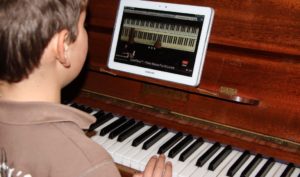
The Masterpieces of Classical Music are presented and simplified in Piano By Number original arrangements! This volume contains “Moonlight Sonata,” Bach’s “Prelude #1,” and “Fur Elise” plus many more favorites.
Imagine being able to play the great masterpieces of Classical Music without having to read music, and on your first try! Look no further than EASY CLASSICAL PIANO.
More complex than any of our other books, each song includes helpful commentary and suggestions for how to practice the piece. This fun, low-pressure piano method will familiarize you with some of the greatest masterpieces of classical music.
- Recommended for older children, ages 8 and up
- Includes sticker template
- Identical to the Printed Version
- FREE pre-printed stickers sent worldwide if requested
- Includes printable template for PIANO BY NUMBER stickers
-
BOGO: Includes a free ebook of your choice
- FREE Piano By Number Mobile Phone APP
- Delivered as a Printable PDF file
- Download the PDF to your tablet or print the pages and play!
- Get it FREE by making it your choice of FREE EBOOK!
Includes Fingering And Commentary
This book is more complex than any of our other books. Each song includes helpful commentary and suggestions for how to practice the piece. It’s like taking a lesson with an experienced teacher. First of all, you’ll note that there are indications (on the left) for “fingers.”
You’ll need to assign numbers to your fingers, as all pianists do, in order to navigate more complicated music. The finger indications are only a suggestion of what you should use. We suggest that you first try the piece many times using any fingers, until you get the idea.
Original Arrangements
The music of Bach’s Prelude #1 is presented exactly as it appears in sheet music versions, that is, nothing has been simplified or altered or arranged. You will play the exact notes of the entire piece that Bach wrote 250 years ago! Some of the more complex pieces have been simplified slightly to put them within your reach, but many appear in their original form.
It’s a great way to get started learning piano!
EASY CLASSICAL PIANO contains 10 Classical Masterpieces that use both the white and black keys of the piano. Using both hands, it is our most complex book for the piano. It is the only one to make use of fingering indications.
Beethoven: Fur Elise | Chopin: Fantasie Impromptu | Debussy: Clair de Lune | J.S. Bach: Minuet | J.S. Bach: Prelude #1 in C | Beethoven: Moonlight Sonata | Mozart: Rondo Alla Turca | Beethoven: Rage Over A Lost Penny (Rondo Capriccio) | Rossini: William Tell Overture (Lone Ranger Theme) | Tchaikovsky: Symphony Pathétique
BOGO
You can get a free ebook with every ebook you purchase.
MEDIA:
We'll email you FREE online access to the PIANO IS EASY Audio Play Along Songs and the 54 minute video from Teach Yourself Piano. The video will show you how to play all 12 major and minor chords. You can play and save these online on any device on our Vimeo channel.











